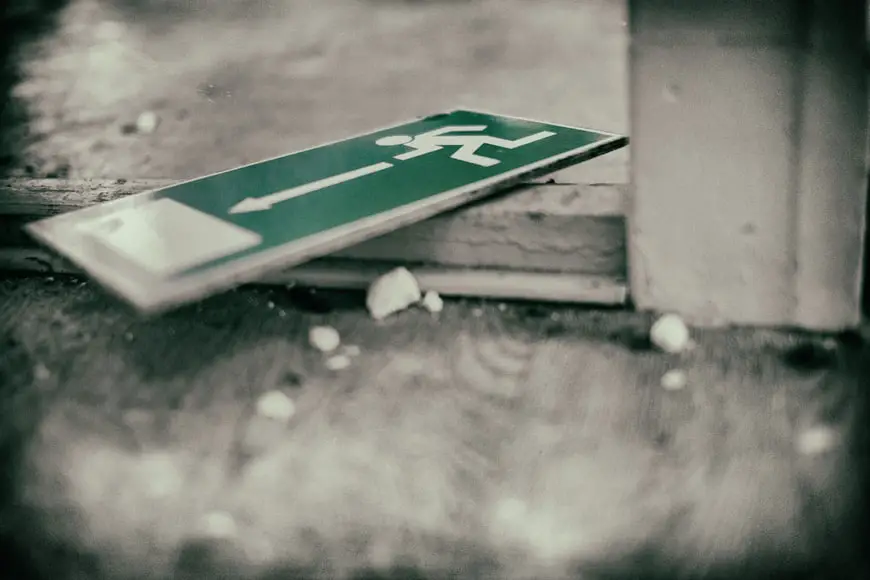If you’ve spent any amount of time learning about survival prepping, then you’ve probably come across the term ‘SHTF’. It refers to a catastrophic event that turns life upside down in an instant, and it is the worst-case scenario that many survivalists are preparing for.
SHTF can be natural disasters, war, pandemics, and other cataclysmic scenarios. There is no guarantee of a forewarning, and there is no limit to the damaging effects it can lead to. With the right supplies and knowledge, survival prepping could save you and your loved ones in a SHTF scenario.
Some people spend lifetimes learning everything about SHTF survival techniques and gathering the best gear and equipment, but being prepared isn’t only for enthusiasts. Preparing for SHTF helps to ensure the safety of you and your loved ones in case of an emergency, and it can be done by anyone on any budget. In this guide, we break-down exactly how to begin prepping, along with a list of essential supplies to keep on hand and a step-by-step guide on what to do if SHTF.
Table of Contents
What is SHTF Survival?
SHTF is an acronym that stands for “Shit Hits The Fan”, or “Stuff Hits The Fan” for those who prefer a less vulgar term. The analogy of the saying paints a dreadfully vivid picture of things escalating from bad to much worse, and the reality of when SHTF would be a similarly catastrophic event that can change lives and interrupt social norms in an instant.
Some of the most likely SHTF scenarios include the following:
- Natural Disaster
- War/Terrorist Attack
- Grid Down
- Nuclear War
- Cyber Attack
- Worldwide Pandemic/Biological Warfare
SHTF survival can also take many different forms based on the type of event that occurs, the environment in which the incident occurs, and the repercussions that follow.
Many SHTF scenarios will have widespread effects that can result in further risks and vulnerabilities. These may include:
- Long term power outages
- Communication breakdown
- Water supply disruptions
- Sanitation issues
- Economic hardships
- Mental and physical health issues
- A lack of or fake law enforcement
- Looting and gangs
Preparing for all possible SHTF scenarios and their resulting outcomes may take years to complete, and there will likely always be more information to explore. However, it’s never too late to begin, and there’s no better time than right now.
How to Prepare for a SHTF Scenario
The best way to prepare for when SHTF is with a logical, planned approach. SHTF survival will not look the same for everyone, and preparing for all possible scenarios takes time, research, and money. By narrowing down the potential risks unique to your location and living situation, you can gain a better understanding of how to prepare and where to begin.
Regardless of the scenario, SHTF situations can occur suddenly and unexpectedly, but thinking about the endless possibilities of catastrophic scenarios can quickly make preparing for SHTF feel overwhelming. Not only is there stress from the uncertainty of what could happen, but the list of possibly useful supplies can seem never-ending and will come with a hefty price tag as well.
Just as with all seemingly insurmountable tasks, however, preparing for when SHTF can be broken down into smaller tasks and completed over time. To beginning the process of preparing for when SHTF, it is best to begin with a plan. Assess your current situation and gain a clear understanding of what you need through the following steps:
- Do your research
- Take inventory
- Formulate a plan
- Start with the basics
By using a logical and thought-out approach, you can get it right the first time without wasting time and money on unnecessary preparations.
1. Do Your Research
Although SHTF scenarios may be unpredictable, there are certain threats that are more likely and immediate than others. Informing yourself about the most likely scenarios facing you and your family will help to pinpoint which tools and supplies are essential for your survival.
When doing research, begin with the most immediate dangers pertinent to your location. Do you live in an area that faces the threat of natural disasters? Are you in a city that could experience grid lock, mobs, or looting if SHTF? Learn about the geographical hazards in your area as well as the resources that would be available if SHTF (medical aid, shelters, natural water sources, etc.)
After assessing your immediate threats, do research on the current state of the world. Is there a threat of war? Are there issues in the worldwide supply chain? Has there been a recent outbreak or attack? Remaining informed about world events will keep you ahead of the game rather than being blindsided if SHTF.
The final step of research has to do with the supplies and information you would actually need if SHTF. Become familiar with recommended tools and supplies, and research brands and models to find the best products and deals.
There is no shortage of available resources, but not all recommendations will apply the same to everyone. When planning your SHTF prepping process, always keep it personal and consider what would truly be beneficial to you and those you are preparing for.
2. Take Inventory
It’s likely that you already have some basic survival supplies. By taking inventory of what you already have on hand can cut down your shopping list and save you money as well. Organize your items and separate what you want to include in your SHTF preparedness kit so that you know exactly what you have on hand and where to find it if you need it.
Before including items that you already have in your SHTF preparedness kit, make sure that they are safe, functioning properly, and complete. Check the expiration dates on all food items, ensure that any tools and devices are functioning properly, and include all necessary accessories, batteries, and chargers.
The process of taking inventory and sorting the items you already have is also a good time to designate a space for your SHTF preparedness stockpile. Choose a cool and dry space to keep food from spoiling prematurely and take measures to secure any items that critters may try to get into.
3. Formulate a Plan
Once you have a better understanding of how prepared you are to begin with, it’s time to formulate a plan to move forward. Consider how many people you’re preparing for as well as how long you’d like your supply to last. With that in mind, you can then determine a realistic budget and time frame to move forward with.
Some people may be able to gather most necessary supplies at one time, while others may find it easier to gradually add to their stockpile over time. There is no wrong way to prepare, so keep your plan realistic within your personal means.
4. Start with the Basics
Whether you are in a hurry to complete your SHTF survival stockpile or plan to grow it over time, it is best to start with the basics. This means food, water, and shelter, as well as any personal items such as medications or mobility devices that you may need.
Once you have your basics, you can begin to add more luxury items. Continue researching supplies and prepping tips, and gradually add supplies and equipment as your budget allows.
Essential Supplies for SHTF Survival
Gathering the basic essential supplies is the easiest place for any SHTF survival prepper to begin. Once those are in place, you can customize your stockpile and add to it gradually over time.
Although having the right supplies is important, it can also be useful to know some basic survival skills. Choose a topic you’re most interested in first, then add to your knowledge base over time as well.
Gather the Essential Supplies
Although not all SHTF survival gear stockpiles will look the same, there are certain items that are considered essential for every situation. Gathering these items will provide you with a solid foundation to build upon and will cover your basic survival needs in case SHTF sooner than expected.
The following 20 items are considered essentials in most survival situations and are a great place to begin when taking inventory and gathering your supplies:
- Emergency Food Stock
- Manual Can Opener
- Water Supply
- Clothing
- First Aid Kit
- Flashlights
- Battery-Powered Walkie Talkies
- Batteries and Chargers
- Medication
- Multitool
- Sanitation and Hygiene Items
- Blankets
- Cash
- Copies of Personal Documents
- Family and Emergency Contact Information
- Fire Starter
- Personal Defense Items
- Map(s)
- Transportation
- Survival Backpack/Bug-out Bag
The American Red Cross recommends a water supply of at least one gallon per person, per day. A 3-day supply is recommended for cases of evacuation, while a 2-week supply is recommended for the home. To maximize space and flexibility when storing water or dry goods, consider using a stackable water storage system.
Customize Your Supply Stockpile
Along with these basic supplies, you may also want to include the following items based on your personal needs and regional risks:
- Medical Supplies
- Baby Supplies
- Pet Supplies
- Extra Car and House Keys
- N95 or Surgical Masks
- Matches
- Candles
- Generator
- Rain gear
- Protective Gear
- Whistle
- Towels
- Work Gloves
- Tools/Supplies for Securing Your Home
- Plastic Bags
- Water Purifier
- Plastic Sheeting
- Duct Tape
- Scissors
- Household Liquid Bleach
- Entertainment Items
- Sleeping Bags
- Hunting/Fishing/Trapping/Foraging Equipment
Learn SHTF Survival Skills
While a stockpile of SHTF survival gear are practical items that you may need in an emergency, you may also want to include some survival education and training. Even with the right supplies on hand, they will only last so long, and we can’t always rely on being able to access them when SHTF at all.
In either event, it will be necessary to find other resources in your environment. Knowing how to find and utilize them, however, often requires specialized knowledge and training that should not be overlooked when preparing for when SHTF.
Survival training includes, but is not limited to, the following skill sets:
- CPR
- Basic First Aid
- Creating Shelter
- Obtaining Clean Water
- Starting a Fire
- Maintaining a Level Attitude Under Stress
- Hunting and Gathering Food
- Harvesting and Utilizing Native Plants
To decide where to begin your survival education, consider not only the types of SHTF scenarios that are most likely to happen, but also the surrounding terrain that you may need to survive from if your supply runs out or you need to relocate.
- Heavy Duty Hard Case: Your reliable guardian! Its robust, impact-absorbing hard case ensures unwavering security for outdoor escapades, road trips, camping, hiking, or at home. Perfect for cuts & scrapes as you embark on your next carefree journey!
- Comprehensive Emergency Kit: Boasts 348 pcs of medical supplies, making it one of the most comprehensive sets available. Contains items to treat a wide variety of injuries & emergencies, ensuring you have all necessary tools & items at your disposal
- Compact & Easy to Store: The organized interior makes it easy to find exactly what you need in any emergency situation. It fits into any storage space or can be tucked away in a bag, making it perfect for campers, backpackers, hikers, & families
- Bonus Mini-First Aid Kit: Comes w/ mini kit containing 32 pcs. This compact & portable kit is perfect for smaller day-to-day emergencies, easily carried in a handbag, backpack, or car glove box. Plus, additional layer of safety & preparedness on outdoor expeditions
What to do When SHTF
Tensions will run high when SHTF, and the panic that follows can make it difficult to think clearly. That is why it is not only helpful, but important to have a plan in place. In any SHTF scenario, your best chance for survival will be to keep a clear head and to think logically.
So what is the first thing to do when SHTF? Instead of overthinking the “what ifs” and possible outcomes, take a deep breath to gather your thoughts and be clear about what is happening. Then you can better proceed with the following steps:
- Communicate with your loved ones. Make sure that everyone is safe and accounted for, and that everyone knows what they need to do next. This could include things like moving to a shelter, packing a bag, or helping another family member.
- Assess the situation. Understand your immediate risks, your options, and an approximate time frame available for you to act.
- Decide whether to stay where you’re at or evacuate.
- Gather supplies and secure shelter. If you feel that it is better to evacuate, then it is best to do so before the situation escalates. By leaving sooner rather than later, you may be able to avoid putting yourself and your family at greater risk before reaching a safe destination. Ensure that you are safe in the short term before hypothesizing possible scenarios and outcomes for the future.
Sheltering at home is often the best option, especially when temperatures are low, in cases of a pandemic or other outbreak, if you have land or a homestead, or if you have a trusted community of neighbors who can help support each other.
If your home is in immediate danger, however, you may be forced to evacuate. Situations when you will need to leave your home may include:
- When your home is threatened by a natural disaster
- When there is civil unrest, particularly in densely populated areas
- In the event of bombings or nuclear war when it is necessary to move to bunkers or fallout shelters
- In an extended SHTF scenario when supplies begin to run out
Once you have taken the immediate steps to secure your safety, you can reassess and decide what to do next.
Conclusion
The best way to begin preparing for SHTF survival is with a plan. A logical approach to prepping will help you gather the supplies and survival skill sets that will help you in an emergency, without becoming overwhelmed or wasting time and money on unnecessary items. With a clear understanding of the potential risks and options, anybody can prepare to survive a SHTF scenario.




